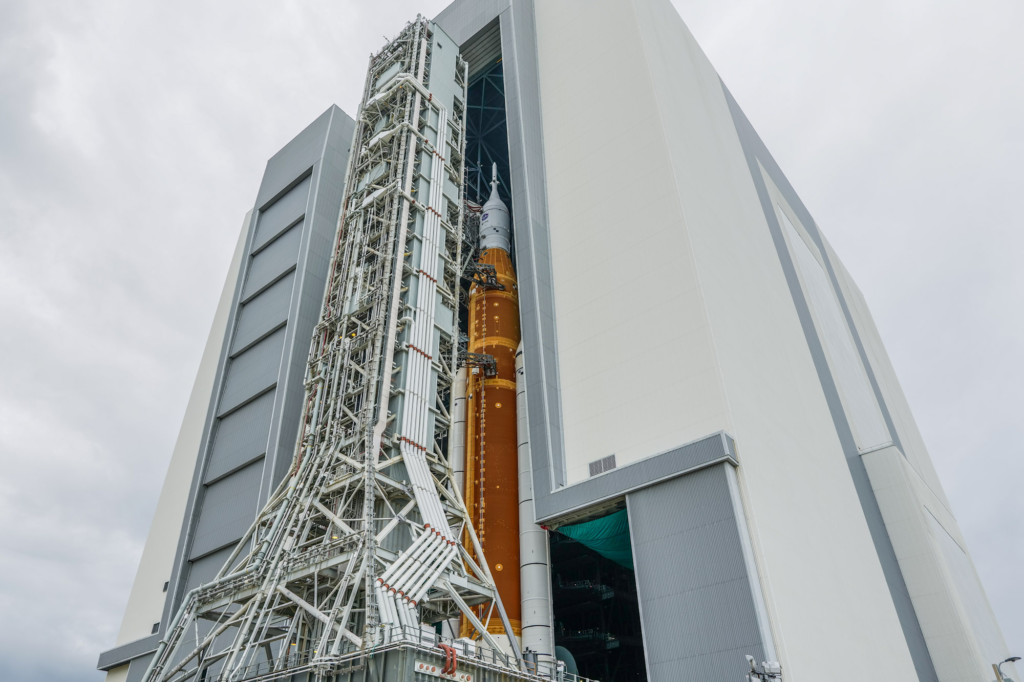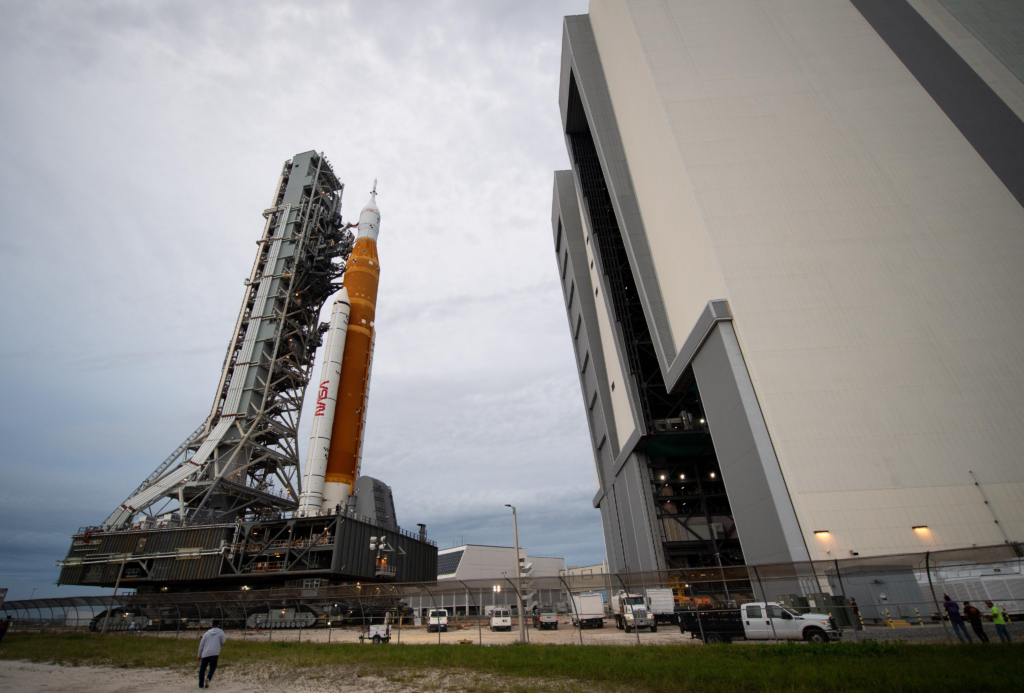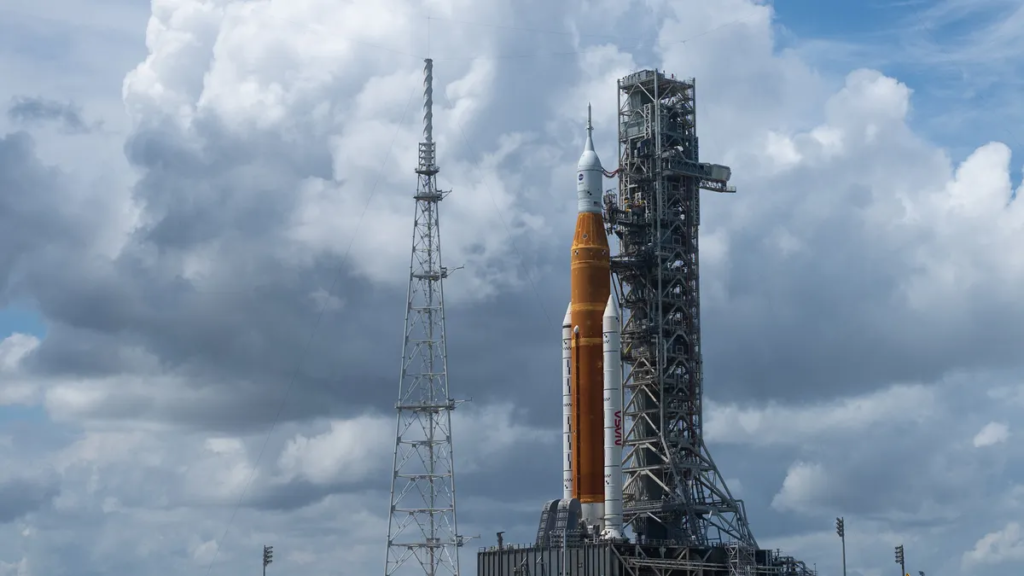
NASA Moves The Space Launch System Back To The VAB
NASA has been trying to launch the Space Launch System for quite a while now. Unfortunately, quite a few complications have gotten in the way including a liquid hydrogen leak, electrical systems, and even a hurricane. All of which are having an impact on the launch date, and further down the road the return of humans to the surface of the Moon.
This being said, the agency wants to make sure they get it right and have Artemis I be a fully successful mission. In the last few days alone the agency has moved the next generation launch vehicle back in the Vehicle Assembly Building or VAB. This serves multiple purposes as they not only need to protect it from the harsh weather but also service batteries and more.
Even a small fire was reported inside the VAB after an electrical issue began to create sparks that landed on a rope marking the work area boundary. While not ideal, it looks as if it was put under control not long after and will not delay any of NASA’s deadlines. Here I will go more in-depth into the recent move into the VAB, leak progress, the small fire, and more.
Back To The VAB

Just a few days ago on the 24th, NASA officially waved off the September 27th launch attempt. Specifically, the agency began preparing for rollback, while continuing to watch the weather forecast associated with Tropical Storm Ian. During a meeting Saturday morning, teams decided to stand down on preparing for the Tuesday launch date to allow them to configure systems for rolling back the Space Launch System rocket and Orion spacecraft to the Vehicle Assembly Building. Engineers deferred a final decision about the roll to Sunday, Sept. 25, to allow for additional data gathering and analysis. If Artemis I managers elect to roll back, it would begin late Sunday night or early Monday morning.
The next day on the 25th, NASA continued to watch the weather and prepare to roll the rocket into the VAB. They closely monitored the weather forecast associated with Tropical Storm Ian as preparations for rolling back the Space Launch System rocket and Orion spacecraft to the Vehicle Assembly Building continue. At the time, the latest information provided by the National Oceanic and Atmospheric Administration, the U.S. Space Force, and the National Hurricane Center indicates a slower moving and potentially more westerly track of the storm than previous predictions showed. They pointed out that NASA managers will meet to evaluate whether to roll back or remain at the launch pad to preserve an opportunity for a launch attempt on Oct. 2.
Finally just two days ago on the 26th, NASA officially made the decision to roll the rocket into the Vehicle Assembly Building. Managers met Monday morning and made the decision based on the latest weather predictions associated with Hurricane Ian, after additional data gathered overnight did not show improving expected conditions for the Kennedy Space Center area. Around 11 pm on Monday, they began rolling the rocket off the pad. At approximately 9:15 a.m. EDT, the SLS rocket and Orion spacecraft for the Artemis I mission were secured inside the Vehicle Assembly Building at the agency’s Kennedy Space Center after a four-mile journey from Launch Pad 39B. NASA reported that after the storm has passed, teams will conduct inspections to determine impacts at the center and establish a forward plan for the next launch attempt, including replacing the core stage flight termination system batteries and retesting the system to ensure it can terminate the flight if necessary for public safety in the event of an emergency during launch. This concluded the rollback process and as of right now, the Space Launch System is inside the Vehicle Assembly Building.
Small Fire & Launch Dates

Now that we know more about why NASA moved SLS back into the VAB and how the process went, we can take a closer look at how this affects the launch schedule and even the small fire that was reported. Starting with the fire, yesterday the agency reported that an assessment was underway on an electrical system. Specifically, at approximately 11:45 a.m. on the 27th, a fire alarm was triggered in the Vehicle Assembly Building at NASA’s Kennedy Space Center in Florida. The notification came when an arc flash event occurred at a connector on an electrical panel in High Bay 3. A spark landed on a rope marking the boundary of the work area. The rope began to smolder, workers pulled the alarm, and employees evacuated the building safely.
The incident occurred on the third floor of F-tower at the Mobile Launcher power connection. Technicians shut down power to the panel, and the center’s emergency responders declared the VAB safe for employees to return to work. NASA reported there were no injuries, and the Artemis I rocket and spacecraft were not at risk. The Artemis I vehicle and mobile launcher entered High Bay 3 earlier that morning after rolling back from Launch Complex 39B in advance of Hurricane Ian, which is expected to bring sustained tropical storm force winds to Kennedy as early as Wednesday evening. Engineers and technicians are currently evaluating the cause.
In terms of the hurricane, as part of NASA’s hurricane preparedness protocol, a “ride out” team will remain in a safe location at Kennedy throughout the storm to monitor center wide conditions. After the storm passes, they will conduct an assessment of facilities, property, and equipment. Once it is safe for additional employees to return to Kennedy, engineers will extend platforms to establish access to the rocket and spacecraft.
This leads us to the launch schedule and when we can expect to see SLS back on the pad. NASA said that managers will review options on the extent of work that will be conducted in the VAB before returning to the launch pad or identifying the next opportunity for launch. Technicians will swap out batteries on the rocket’s flight termination system and retest the system prior to the next launch attempt. It’s important to point out that in order to determine potential launch dates, engineers identified key constraints required to accomplish the mission and keep the spacecraft safe. The resulting launch periods are the days or weeks where the spacecraft and rocket can meet mission objectives. These launch periods account for the complex orbital mechanics involved in launching on a precise trajectory toward the Moon while the Earth is rotating on its axis and the Moon is orbiting Earth each month in its lunar cycle. This results in a pattern of approximately two weeks of launch opportunities, followed by two weeks without launch opportunities.
Right now we are in the launch period that stretches from September 19th to October 4th. Based on the recent return to the VAB, hurricane conditions, and some additional complications, it’s extremely unlikely that we will watch a launch attempt within the next week. This means NASA will need to at least wait until the next launch period. This next period starts on October 17th and goes until October 31st. Unfortunately, when asked about the possibility of a launch attempt in the month of October, Jim Free, associate administrator for NASA said, “I won’t write it off, but it is going to be difficult.” All of which suggests that the soonest we could see the next Artemis I launch attempt could be the November launch period which goes from the 12th to the 27th. This being said, right now NASA is determining what options they have and when they will try again to launch the Space Launch System and Orion spacecraft. In addition to the launch opportunities based on orbital mechanics and performance requirements, there also is an operational constraint driven by infrastructure at NASA’s Kennedy Space Center in Florida. Because of their size, the sphere-shaped tanks used to store cryogenic propellant at the launch pad can only supply a limited number of launch attempts depending on the type of propellant. Liquid oxygen and liquid hydrogen are loaded in the rocket’s core stage and upper stage on the day of launch. Should the launch subsequently be called off, there is a minimum of 48 hours until a second launch attempt can be made. There is then a 72-hour minimum before a third attempt can be made, due to the need to resupply the cryogenic storage sphere with more propellant from nearby sources. In any given week, no more than three launch attempts that include core stage tanking can occur.
Not only this, but other factors like the flight termination system batteries have control over the launch period. To meet the requirement by the Eastern Range for the certification on the flight termination system, currently set at 25 days, NASA is required to roll the rocket and spacecraft back to the VAB before the next launch attempt to reset the system’s batteries. The flight termination system is required on all rockets to protect public safety. This continues to apply overtime if the rocket leaves the VAB and is on the pad for a certain amount of time. For the time being we will have to wait and see what NASA decides based on all these different factors and considerations.
Conclusion
NASA has been trying to launch SLS and Orion for quite a while now. After multiple scrubbed launch attempts and trips to and from the VAB, the agency is currently trying to decide when they can actually launch this rocket. Over the last couple of months, a host of different issues have arose that continue to stall the launch and in the grand scheme of things the Artemis missions. We will have to wait and see how it progresses and the impact it has on the space industry.
